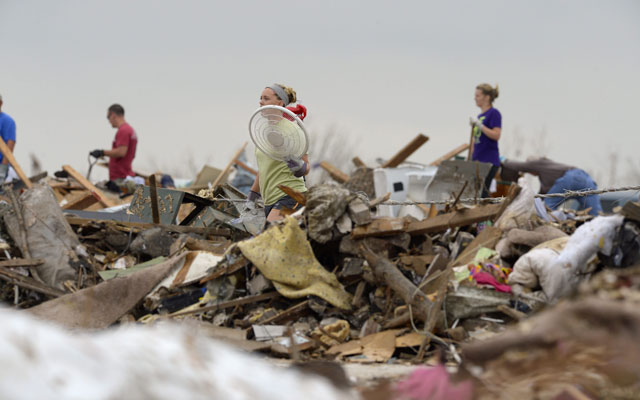In response to the tornado that struck the Moore, Oklahoma, area last week, the National Guard mobilized 250 personnel to assist state and local response forces. The Guard brought unique capabilities critical to restoring security and safety in the devastated area. The people of Oklahoma—and the United States—owe a great deal of gratitude to the Guard and the firefighters, policemen, and Emergency Medical Technicians (EMT) that they support during such tragedies.
In the aftermath of the tornado’s destruction, the Guard used a number of unique capabilities to aid its state and local counterparts. The obvious capability the Guard brings is strength in numbers. The 250 Guardsmen and women insert more helping hands to the effort, but more importantly they do so with a great understanding of the chain of command and carrying out instructions and missions. These numbers also include the Guard’s assets. During this effort, the Guard deployed its members with 46 vehicles, helping to save precious time while moving response forces between locations.
The Guard has also been able to search through the debris with infrared sensors, has used radio communications to work with responders on the ground as well as helicopters surveying from above, and has delivered more than 2,000 pounds of meals to feed the responders. The latter point exemplifies how the Guard can provide logistical support to these efforts, which in turn facilitates the responders’ ability to operate at a strenuous level.
A critical way in which the National Guard operates during disaster response is through its Joint Operations Centers (JOCs). The JOC for the Oklahoma tornado response is in the National Guard Joint Headquarters in Oklahoma City. Through this office, the Guard received information from state and local response forces about the damage and immediate aftermath, received requests for Guard involvement, and then executed the deployment of these Guard members. Lieutenant Colonel Hiram Tabler, the Guard commander in this response effort, described the process:
Thus far, the JOC has tasked aviation support overall situational awareness; a military liaison on the ground; Air National Guard security forces and air support operations squadron; civil support teams to open military communications and command posts; and search and rescue teams to support civilian agencies on the ground.
Through this system, the JOC streamlines the efforts of the Guard and their communications with local forces, enabling them to support response efforts efficiently.
In addition to natural disasters, the Guard provides critical support in the event of a chemical, biological, radiological, nuclear, and high explosive attack (CBRNE). Through support to civil authorities during such an attack, the Guard can mobilize teams of roughly 200 service members with medical, search and extraction, and decontamination expertise to the scene of an incident. Even during natural disasters, these forces can come in handy as nuclear power plants and other industrial sites have the potential to release such hazardous materials.
The National Guard is a critical force for U.S. national security, both in the homeland and when they are called up to serve abroad. Though the federal government and many states continue to face fiscal instability, they cannot lose sight of those forces that come to the aid of U.S. citizens when disaster inevitably strikes. As it is the Guard’s duty to defend and protect the homeland, it is the constitutional responsibility of government to provide for the common defense.
























